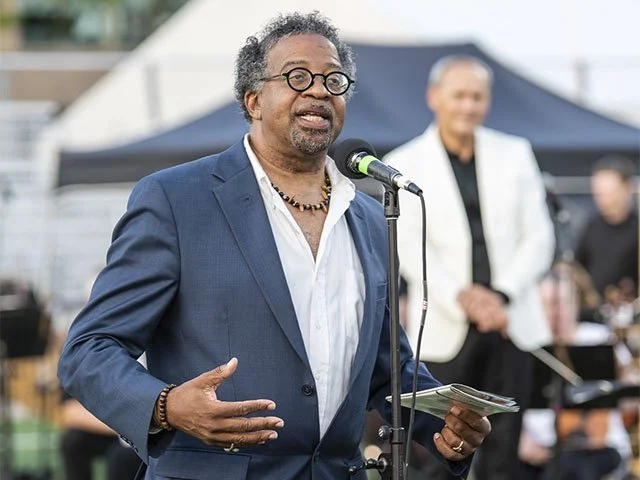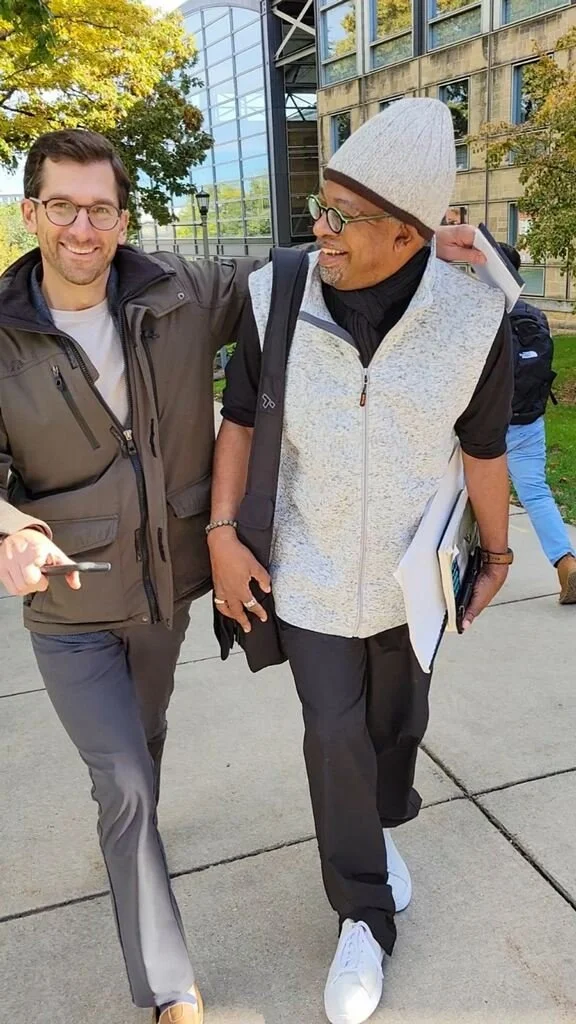Bill Banfield Wisconsin Symphony Orchestra Composer Residency
Bill Banfield with the WCO at one of last summer's Concerts on the Square. It’s a sad story that has a happy ending.
Composer Bill Banfield’s Symphony No. 8 — Here I Stand, based on the life of Black activist/actor/bass-baritone Paul Robeson — was commissioned in 2000 by the New England Conservatory of Music, where Banfield did his undergraduate work. Prior to its premiere, however, the conservatory’s president left and the planned concert was canceled.
Banfield had a digital version of the score, but during a technology upgrade, the written symphony was lost in the electronic shuffle. Today, Banfield is pretty matter-of-fact about the loss — probably because the lost symphony has been found. After a decade or so, Banfield’s copyist, Peter Kienle, located a copy of the score.
So finally Here I Stand will receive its world premiere on Jan. 28 at the Overture Center as the first concert of the Wisconsin Chamber Orchestra’s 2022 Masterworks series.
Bill with CEO of Wisconsin Symphony Orchestra, Joe Lohnis
In 2021, Banfield began a three-year term as Wisconsin Chamber Orchestra’s inaugural composer-in-residence. The group is taking steps to increase diversity in its offerings and help broaden its audience. Banfield, who is Black, is also an experienced music educator.
Wisconsin Chamber Orchestra maestro Andrew Sewell and Banfield met when both were graduate students at the University of Michigan in the late 1980s. Sewell was earning a master’s degree in conducting; Banfield a doctorate in composition. “Bill Banfield’s Symphony No. 8 is an approachable work covering a wide musical palette from simple melody to multilayered complex structures using contrapuntal and episodic forms,” says Sewell. “The music is reflective, buoyant and full of life, a fitting tribute to Robeson’s artistry and legacy.” Banfield and the orchestra collaborated with the UW-Madison Department of Communication Arts and graduate student Rigoletto Lopez to create a video highlighting Robeson’s artistic and social contributions that will accompany the symphony.
Banfield is retired from a professorship at the Berklee College of Music in Boston but remains active in performing, research and educational initiatives. He has composed 13 symphonies, nine operas, seven concerti, two ballets, and countless pieces of chamber, jazz and popular music. Jazz musician Quincy Jones signed him up to create a curriculum and text to teach popular music in America’s public schools, one of six books the musician has written. He cites Detroit Symphony conductor Paul Freeman and jazz trumpeter Marcus Belgrave as mentors who helped shape his musical career and his social views.
Banfield graduated from Detroit’s Cass Technical High School (which boasts other celebrated alumni including singer Diana Ross, jazz trumpeter Donald Byrd, comedienne Lily Tomlin, and automotive engineer John DeLorean). Banfield credits the environment and the times for sparking his musical interests.
“What draws young people to the arts is what’s inside of them and how their environment opens them up to arts experiences,” Banfield says. “I was living in a vibrant city at a vibrant time. We had everything from the Detroit Symphony Orchestra to Motown.”
In the largely white world of classical music, Banfield sees challenges, but also enormous opportunities. “The most important thing is to recognize Black classical artists, do justice to the canon and perform music that matters to our time,” Banfield says. There is the composer born into slavery but recognized as the “Black Mozart”: Joseph Bologne, Chevalier de Saint-Georges. There are contemporary artists including Florence Price, William Grant Still, George Walker and Patrice Rushen (whose composition Sinfonia also will be performed by the orchestra on Jan. 28), but their contributions are often overlooked.
“This past September [New York’s] Metropolitan Opera did Fire Shut Up in My Bones, the second opera by trumpeter Terence Blanchard, the first Black composer whose music The Met has performed,” Banfield notes. “Music is the sound of the universe telling you that it’s time to listen, but American orchestras are extremely problematic in their practices.”
Banfield will continue expanding the understanding and appreciation of Black concert composers and their music. Next up on the orchestra’s calendar will be Banfield’s first commissioned work for the Madison group, now called Tones, Tunes and Time, that Sewell describes as “an approximately 12-minute work with narrator, saxophone soloist, strings and piano, based upon the speeches and words of Frederick Douglass.” It’s scheduled for a Concerts on the Square performance in July.
The final year of the residency, 2024, will bring the world premiere of the second commission, his Symphony No. 14, Revelations. It speaks to the need for cooperation, with more than a nod to the Biblical Book of Revelations.
“I believe in the transformative power of art and culture, and without it we risk having a dead society,” Banfield says. “We need new revelations for these troubled times.”
In the meantime, Banfield will continue his efforts to open the world’s ears to the power and grace of Black composers.
“If I could with my art strike a blow against mediocracy, thumb my nose at power, hate and unjust action, and pull from life a creative melody that guarantees a sigh, and wonder about beauty, that would be a goal to work for, live for, and die happily having tried,” Banfield says.

